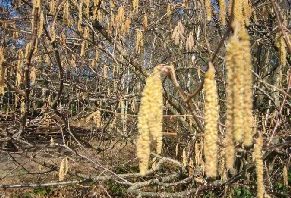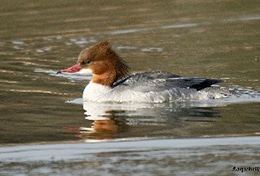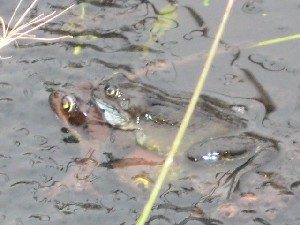Spring has arrived at Stover and it won’t be long before many of the animals that have hibernated over the winter will start to emerge. Look out for the white blooms of blackthorn (blackthorn flowers before it comes into leaf) which is vital for quite a few early insects. February saw the water levels drop with only 4mm of rain falling at Stover.

The pussy willow catkins are due to open, joining the hazel and alder which have been open since last month, and will shed their pollen before the leaves unfurl and get in the way. The pollen attracts the blue-tits and provides an early source of nectar for many insects. Peacock and small tortoishell butterflies along with bees make use of the pussy willow catkins especially, so keep an eye out for these species.
Elder and hawthorn leaves emerge during March along with nettle leaves. However, due to the overall mild winter the plants are nearly a month ahead and nettle leaves have been growing for many weeks now. The spring blooms lure the early insects too; coltsfoot should soon be in flower joining with wild daffodil, primroses, celandine and violets which flowered early. Cuckoo pint leaves are already fully out along with dog’s mercury, and ramson leaves are pushing up.
The marsh marigold should flower this month; the leaves are now visible in the southern marsh. Ivy berries are ripening now rather than in the autumn providing food for fruit-eating birds such as the thrushes. There is an abundance of the scarlet elf cup fungi in the woods at the moment.
The tufted duck and pochard numbers will start to decrease during March, marking the end of winter, as they head back north to Russia. Pochard have been noticeably sparse again this winter with a maximum of two recorded during last month. 28 tufted duck were recorded on the 7th. Up to 11 mandarin ducks remained on the lake during February compared to 26 in the same month last year. Cormorant numbers have been average with a maximum of 5; they are now displaying their white thigh breeding patches. Some of the black-headed gulls now have their summer plumage (black heads); their numbers will start to decrease during March. The cob swan can be seen swimming about with his wings raised and displaying with the pen. Both have been busy nestbuilding last month and it shouldn’t be long before the egg laying starts. One of last year’s cygnets left the lake on the 10th, with the remaining 3 unable to take the hint that they are no longer welcome by their parents. All of the cygnets had left by the end of February last year. Five other swans landed on the lake on the 19th but were swiftly chased away by the resident pair. One of the newcomers was identified by their leg ring as being a previous cygnet from some years ago. A coot made a start on a nest at the end of the month which is early.
A second great-crested grebe arrived on the lake on 22nd March after over-wintering elsewhere, joining the grebe that had been at Stover off and on since December. The grebes usually check out suitable nest sites in March and partake in an elaborate courtship display which is worth witnessing – they raise their crests, collect waterweed and tread water whilst rising beak-to-beak. The little grebe was not as visible on the lake during February, only being sighted on the 24th. Additionally,

up to 8 goosanders, 4 Canada geese, 2 wigeon, and 3 shovelor were recorded during February.
Our local blackbirds and starlings are already entering their breeding season, but those that are just winter visitors to Stover have first to migrate back to their breeding grounds. You can see the difference between visitors and residents by looking at their beaks. Our resident male blackbirds already have their bright golden yellow bills, but continental birds have beaks which are mostly brown. The starlings which are about to migrate have dull bills whereas those of residents are a brighter yellow. Song thrushes started singing on 6th February, joining the mistle thrushes, but we’re still waiting for the blackbirds. The past two years they started singing on 14th February so it shouldn’t be long.
Great-spotted woodpeckers were first heard ‘drumming’ on trees to mark their territory in mid-January and have carried on throughout February.
The smaller birds such as the tit family will start nest building this month. Tawny owls will soon be sitting on eggs if they’re not already doing so. During mild winters the first of the resident birds have young in their nests by the end of the month. There has been some interest shown in the nest boxes on warmer days and the long-tailed tits have been seen inspecting suitable nest sites in the gorse.
Look out for the aerial displays of sparrowhawks as they set up their territories over woodlands. Male woodcocks also start their territorial flights in March – at dusk they fly in circles within the woodland holding their beaks down and emitting strange whistles and croaks.
Keep an eye out for the early migrant birds returning from Africa during March. Chiffchaffs, the earliest bird of passage and the bringer of Spring, will be returning from the Mediterranean and West Africa this month. However, a few overwinter in Britain so don’t automatically assume you’ve heard your first summer migrant ! Sand martins and swallows are due in any day now so keep an eye out over the Lake where they will soon be feasting on the insects.
Warm sunny days during March should bring brimstone, peacock and small tortoishell butterflies out of hibernation and should also activate the wood ants. The first butterfly of the year to be spotted was a peacock on 14th February (last year it was a red admiral on 25th February), and 3 brimstone on the 19th. March is a time of great activity for male weasels as they set out in search of mates. Their territorial system breaks down as the dominant males begin to range more widely. At the same time they become much more diurnal, and they are, therefore, more likely to be visible now. Pregnant vixens will be sorting out suitable earths for rearing their cubs which will be born this month. Not only will they select one in which to give birth, but also others to which they can move their cubs if disturbed. Squirrels start the year early, mating in January and February, so by now the females are ready to give birth and make special nursery dreys in the trees. The dreys are easy to see at this time of year, when the trees are still bare. On mild evenings keep an eye open for bats – they come out of hibernation whenever there is a warm spell in the winter weather and midges and other insects are about. Pipistrelles and natterer’s bats were recorded during the winter bat box checks last month. Most boxes were empty as the bats prefer to hibernate in places where the temperatures remain constantly cold, however the past couple of years winter bat box checks have shown that they are used for hibernation by a small number of bats.
March sees the start of the newt breeding season and the males should now be showing off their brightest colours. Now should be the time when reptiles generally emerge from hibernation and, as they need to warm their bodies to obtain the energy to hunt and mate, they spend a lot of time basking in the sunshine. Keep an eye out for grass-snakes in the marsh and adders on the heathland. The latter emerge from underground holes around tree roots where they’ve spent the winter. It is also peak frog-spawning time now so again keep an eye out for toads and frogs returning to their breeding ponds this month. During March the pike in the lake lay their eggs amongst the weeds in shallow water.
